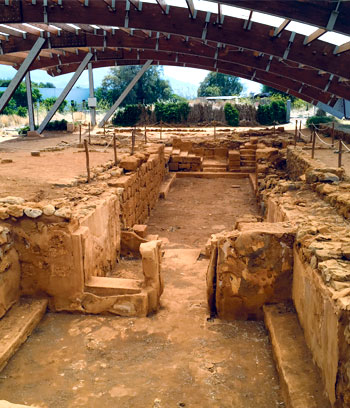 The archaeological site of Malia (Minoan Palace of Malia) is located at the north coast of Crete and is just 3 kilometers east of Malia, close to Potamos Beach. The palace of Malia is the third largest palace in Crete after those of Knossos and Faistos, covering an area of 7,500 square meters. According to mythology, Sarpidon, Minos’ brother and Zeus’ and Europe’s son, reigned at this palace.
The archaeological site of Malia (Minoan Palace of Malia) is located at the north coast of Crete and is just 3 kilometers east of Malia, close to Potamos Beach. The palace of Malia is the third largest palace in Crete after those of Knossos and Faistos, covering an area of 7,500 square meters. According to mythology, Sarpidon, Minos’ brother and Zeus’ and Europe’s son, reigned at this palace.
Man’s presence in Malia is dated back to Neolithic period about 6000 – 3000 BC and was continued during the Minoan era. Residences –before the existence of palace– have been found, dated approximately 2500 – 2000 BC, under the palace of Malia. Unfortunately, the ancient name of the city still remains unknown today. It is assumed that the name may have been Tartarus or Milatos.
According to the archaeological findings, the palace of Malia was built in 1900 BC, while around it, the settlement was developed, which is still preserved, and thus it was turned into a palatial center-city. The palace was destroyed by an earthquake. The new one was built approximately in 1650 BC above the ruins of the old one, maintaining the basic design of the previous one. The final destruction was about in 1450 BC by fire. The views, concerning the causes of disaster, are a controversial issue among scientists, since there is an ambiguity about the causes that lead to it, specifically if it was destroyed because of war conflicts or natural disasters.
Like the other Minoan palaces, the Minoan Palace of Malia was organized around a large rectangular courtyard, which was the central one, to which the entrances converged. The palace had two floors with an oblong shape and four wings. The most important part of it was its western side. Warehouses with many pots and jars, royal rooms, craftsmen’s workshops and room with weapons were found. The main entrance of the palace was the north one and through corridors, the communication with the main parts of the palace was easy.
The courtyards and the palace spaces had particular features. The central courtyard of the palace was surrounded by a paved plateau (the so-called pompikoi dromoi) that expanded in the palace. In addition to the structure of the palace, there were stairwells, air shafts, polytheras (a Minoan structural system) and monumental facades. Also each side was defined in order to process certain functions. Moreover, there was a system of water channels and collectors which were expanded in the palace storage areas.
The entire settlement and of course the palace were rich enough. They cut their own coins by having on both sides the goddess Athena and two dolphins as depictions. Also, there were potteries and workshops specializing in craftsmanship and in the art of engraving seals. Apart from residents’ occupation with workshops, they were engaged in agriculture, fishing and commerce too.
As far as the discovery of the palace is concerned, the reason for it was when, in 1880, the owner of the area Elliniko Livadi discovered some gold leaves at the western side of the palace. As a result to this event, the whole area was excavated by gold diggers and thus the area was named Chrysolakkos (place with gold). The excavations began in 1915 by archaeologist Iosif Hatzidakis and were continued in 1922 by the French Archaeological Service.
Most of today’s visible ruins belong to the new complex of the palace, that is to say the second palace, while part of the first palace survives at the northwest side of the complex.
Should you need additional information please visit the relevant page of the Ministry of Culture